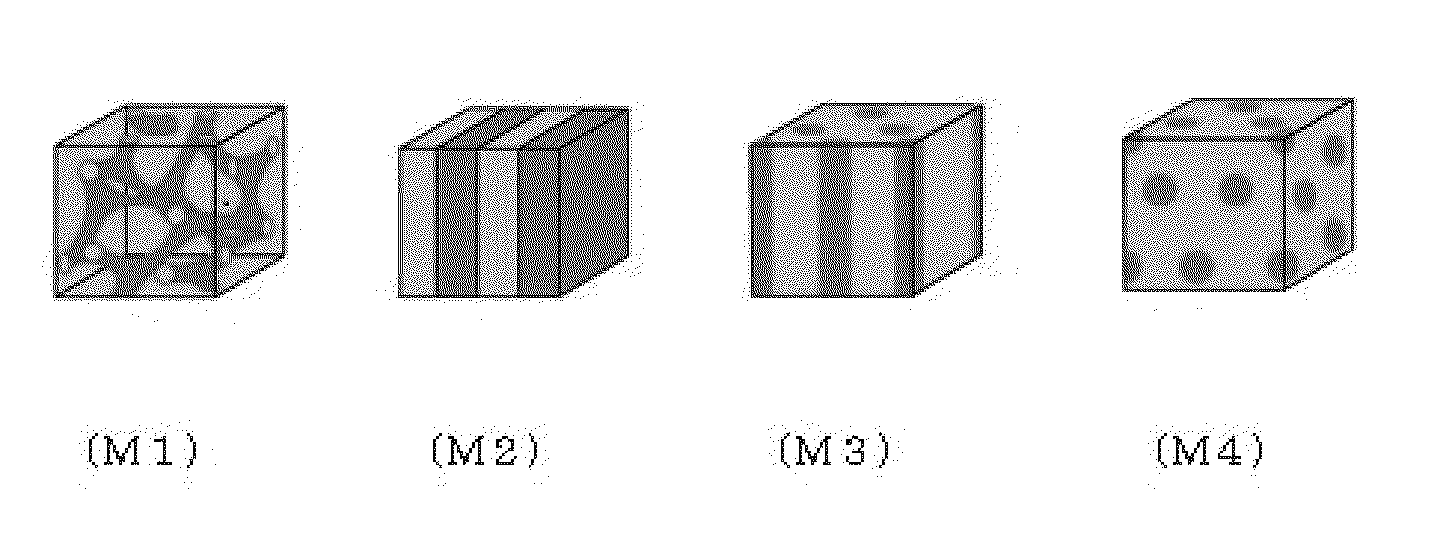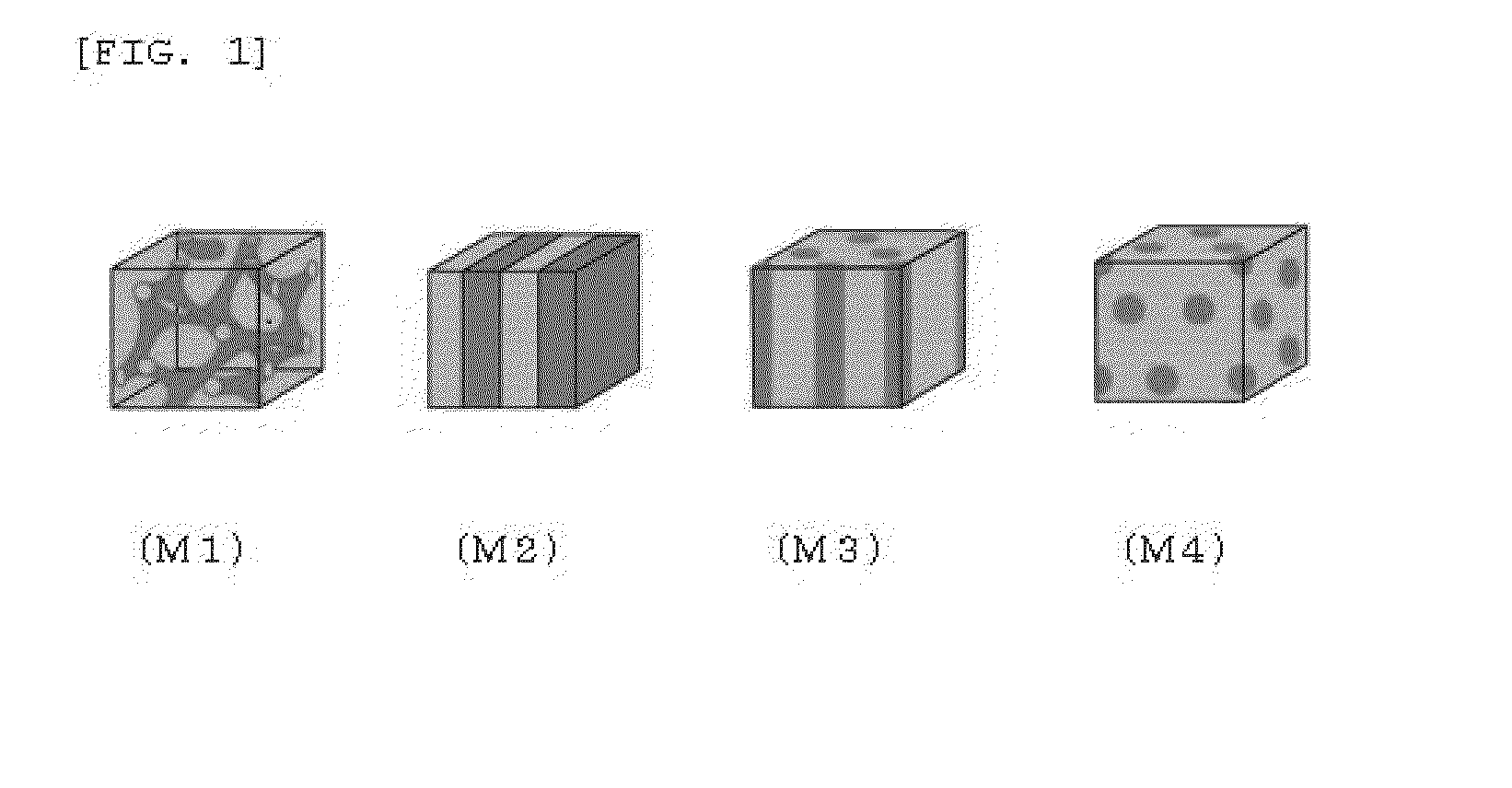Molded article of polymer electrolyte composition and solid polymer type fuel cell using same
a technology of electrolyte composition and polymer type, which is applied in the direction of basic electric elements, electrochemical generators, conductors, etc., can solve the problems of large fuel crossover, loss of membrane mechanical strength and physical durability caused by swell-drying, and extremely expensive fuel transfer amount, etc., to achieve excellent mechanical strength and chemical stability, excellent proton conductivity, and high output
- Summary
- Abstract
- Description
- Claims
- Application Information
AI Technical Summary
Benefits of technology
Problems solved by technology
Method used
Image
Examples
synthesis example 1
Synthesis of 2,2-bis(4-hydroxyphenyl)-1,3-dioxolane (K-DHBP) represented by the general formula (G1)
[0272]
[0273]To a 500 mL flask equipped with an agitator, a thermometer, and a distilling tube, there were added 49.5 g of 4,4′-dihydroxybenzophenone, 134 g of ethyleneglycol, 96.9 g of ortho-trimethyl formate, and 0.50 g of p-toluenesulfonic acid monohydrate, to be dissolved. The solution was agitated for 2 hours while being kept at the temperature of 78° C. to 82° C. Furthermore, the internal temperature was gradually increased to 120° C. and the heating was continued until the distilling of methyl formate, methanol, and orthotrimethyl formate completely stops. After cooling of the reaction solution to room temperature, the reaction solution was diluted by ethyl acetate, and then the organic layer was rinsed with 100 mL of 5% aqueous solution of potassium carbonate. After separating the solution, the solvent was distilled out. 80 mL of dichloromethane was added to the residue, crysta...
synthesis example 2
Synthesis of disodium 3,3′-disulfonate-4,4′-difluorobenzophenone represented by the general formula (G2)
[0274]
[0275]A 109.1 g of 4,4′-difluorobenzophenone (Aldrich reagent) was caused to react in 150 mL of oleum (50% SO3) (reagent of Wako Pure Chemical Industries, Ltd.) for 10 hours at 100° C. Then, the solution was gradually poured into a large volume of water, and after neutralizing the solution by using NaOH, 200 g of sodium chloride was added and the synthesized product was precipitated. The precipitated product obtained was separated by filtration, followed by recrystallization by using ethanol aqueous solution, and thus there was obtained disodium 3,3′-disulfonate-4,4′-difluorobenzophenone represented by the general formula (G2). The purity was 99.3%. The structure was confirmed by 1H-NMR. The impurities were quantitatively analyzed by capillary electrophoresis (organic substances) and by ion chromatography (inorganic substances).
synthesis example 3
Synthesis of Oligomer a1′ not Containing an Ionic Group, Represented by the General Formula (G3)
[0276]
where, in (G3), m is a positive integer.
[0277]To a 100 mL three neck flask equipped with an agitator, a nitrogen gas inlet tube, and a Dean-Stark trap, there were added 16.59 g of potassium carbonate (Aldrich reagent, 120 mmol), 25.8 g of K-DHBP (100 mmol) obtained in the Synthesis Example 1, and 20.3 g of 4,4′-difluorobenzophenone (Aldrich reagent, 93 mmol). After nitrogen purge, the resultant content was dewatered in 300 mL of N-methylpyrrolidone (NMP) and 100 mL of toluene at 160° C. Again, the resultant content was heated and the toluene was removed, then was polymerized for 1 hour at 180° C. Purification was performed by reprecipitation through the use of a large quantity of methanol, and thus there was obtained the oligomer al not containing an ionic group (terminal OM group; meanwhile, the symbol M in the OM group signifies Na or K, and the subsequent expression follows this ...
PUM
| Property | Measurement | Unit |
|---|---|---|
| weight % | aaaaa | aaaaa |
| mean particle size | aaaaa | aaaaa |
| temperature | aaaaa | aaaaa |
Abstract
Description
Claims
Application Information
 Login to View More
Login to View More - R&D
- Intellectual Property
- Life Sciences
- Materials
- Tech Scout
- Unparalleled Data Quality
- Higher Quality Content
- 60% Fewer Hallucinations
Browse by: Latest US Patents, China's latest patents, Technical Efficacy Thesaurus, Application Domain, Technology Topic, Popular Technical Reports.
© 2025 PatSnap. All rights reserved.Legal|Privacy policy|Modern Slavery Act Transparency Statement|Sitemap|About US| Contact US: help@patsnap.com



